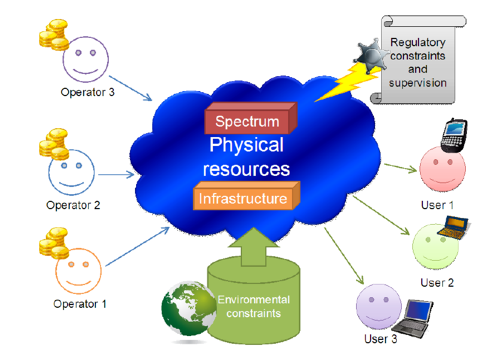Assessing the benefits of physical resource sharing in wireless access networks
Supervisors: Ljupco Jorguseski (TNO), Remco Litjens (TNO), Haibin Zhang (TNO)
e-mail: ljupco.jorguseski@.tno.nl
phone: ++31 15 2857154
mob: ++31 651219560
Our Fascination
TNO is a leading, independent knowledge company whose expertise and research make an important contribution to the competitiveness of companies and organisations, to the economy and to the quality of society as a whole. TNO's unique position comes through its versatility and capacity to integrate knowledge. Some 4300 professionals work at TNO.
Your Work Area
The department Access Network Technology, which is a part of the business unit Communication Technologies, provides consultancy, develops tools and gives independent advice on using fixed and wireless access network technologies. Our main focus in wireless technologies includes radio spectrum management, radio resource management, radio planning, optimization and measurement for UMTS/HSPA (3G), (Mobile) WiMAX, Long-term evolution (LTE), etc. Our expertises results in technical innovations and are for example used by departments of the government, operators (e.g. KPN) and the industry.
Project Background
The classical approach for wireless network operators is to have exclusive use of the wireless network resources such as spectrum, sites, transmission lines, core networks, etc. Only site sharing, driven by the lack of site locations and environmental aspects, has been widely adopted as form of ‘resource sharing’. However, recent developments show further expansion towards the concept of ‘resource sharing’ i.e. wider network infrastructure sharing and, as expected in the future, spectrum sharing. Future spectrum sharing can be expected due to the 3GPP specifications of multi-carrier options in advanced wireless access systems (e.g. HSPA+, LTE-Advanced) and the fragmented spectrum bands owned by different operators.
The drivers to expand the area of ‘physical resource sharing’ can be cost-oriented (e.g. lower CAPEX and OPEX), customer-oriented (e.g. higher capacity, coverage, end-user quality), regulatory (e.g. satisfying licensing agreements), environmental (e.g. reduced number of sites, power consumption), etc. This concept of physical resource sharing is presented in Figure 1.

Figure 1 Physical resource sharing (source: FP7 project SAPHYRE)
Project Description
The project shall address several challenges in the development of physical resource sharing concept for wireless access networks:
- Define meaningful scenarios and use cases for spectrum and/or infrastructure sharing in wireless access networks.
- Propose methodologies, algorithms, and architectures for spectrum and/or infrastructure sharing in technology-agnostic fashion.
- Assess the costs (CAPEX and OPEX) and benefits of the proposed resource sharing methodologies, algorithms, and architectures.
The project will contain the following steps:
- Scenarios and use cases for spectrum and/or infrastructure sharing to be investigated:
a. Perform state of the art analysis on resource sharing algorithms
b. Perform technology scan on operator practices, use cases, and expectations for resource sharing. - Development of resource sharing methodologies, algorithms, and/or architectures as advancement in the state-of-the-art.
- Definition of the evaluation approach for the cost-benefit analysis of the derived resource sharing methods/algorithms
a. Develop evaluation framework (analytical, semi-analytical, and/or simulations)
b. Validation of the evaluation framework - Cost-benefit evaluation, reporting and conclusions
Note here that this project will be aligned with the research directions in WP4 “Cross-layer design for resource sharing” from the IST FP7 project SAPHYRE (see www.saphyre.eu). TNO is a partner in this IST project together with 10 international parties (leading industry, universities and mobile operators).
Benefits for students
- Understanding of advanced radio access technologies
- Detailed insights into modeling and evaluation of resource sharing methods/algorithms
- Experience with large international (IST) projects
Your Qualities
You have an academic background in Electric Engineering or related area, and
- Knowledge of/ experience in wireless communication systems;
- You have experience with building simulators in Matlab or C/C++;
- You are a good communicator;
- You like to apply your knowledge to practical applications.
Time Plan
The project is expected to take around 6-8 months. In order to have good alignment with the SAPHYRE project the work should not start later than September 2010.
